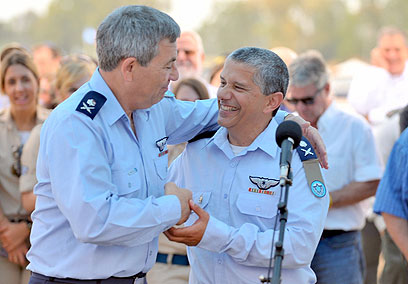
"I believe that the Air Force is well prepared for its missions," outgoing IAF Chief Major-General Ido Nehushtan said Sunday.
Nehushtan's statement came in response to a question presented at a press briefing, which inquired about the IAF's readiness for a large military strike. The allusion to Iran was clear and Nehushtan's reply resonated clearer.
Related stories:
- New IAF chief: We're ready for anything
'Eshel will prepare perfect attack plan'
Drawing focuses on Iran's nuke work
Nehushtan retired from the IDF this week, after 37 years in service. Maj.-Gen. Amir Eshel, Israel's new IAF chief, echoed his predecessor's sentiment upon taking office, saying that Israel's Air Force was "ready for every scenario."
The retiring IAF chief did qualify his statement, saying that the force's capabilities are not static: "The IAF chief has to be able to explain what can be done given the needs and the circumstances, which are constantly changing."

Nehushtan (L) and Eshel (Photo: Avi Roccah)
Thus, while the IAF is currently ready and able to successfully carry out such a mission, the matter of a possible strike on Iran would have to be reviewed as it is discussed by the political and military echelons, in real time and in line with other strategic and technical consideration, as they become evident by in the international arena and in Iran itself.
In any case, the outgoing IAF chief was not about to drop the proverbial bomb in his farewell briefing.
'Situation constantly changing'
During his time in office, Nehushtan conducted himself very carefully, keeping a low profile for the most part; despite the fact that the scope of the IAF's operations under his command was hardly modest.
In his four years in office, the corps noted 650,000 flight hours – 150,000 of them operational – and struck 7,000 targets. An additional 150,000 airborne hours were performed by drones.
The data alludes most of all as to the scope of training, especially for long-range strategic missions – which is a code-phrase often used to describe the Iranian issue – as well as to the growing importance of drone operations in the IAF.
The Air Force suffered four deadly training accidents during those four years, but overall, Nehushtan's IAF had a stable safety record.
Nehushtan characterized his term as one riddled with rapid regional changes and strategic and budgetary uncertainties, which meant he had to constantly adjust the corps accordingly.
"The strategic situation mandates that we rethink our defense dogma and adapt it to an ever-changing strategic and budgetary reality," he said.

New era. Iron Dome (Photo: Avi Peretz)
In April, he added, he nearly had to suspend all flights due to a real concern that the corps was lacking spare parts for maintenance, fuel and munitions.
A force to be reckoned with
Nehushtan admitted that the State allocates generous resources to its Air Force, but stressed that the need to be simultaneously ready for multiple scenarios means that when the IDF formulates its next five-year plan, the IAF will require a bigger piece of the budget pie.
"My foremost challenge was to develop the corps' quality, maintain it and leave a better IAF behind me," he said. "The IAF has some of the most advanced capabilities in the world."
Nehushtan's term focused on five avenues: Operations, bolstering the force, maintaining the quality of human capital and organizational culture, intensive training and better collaboration with the Ground Forces.
His greatest successes were noted in the fields of operations and force-building. He oversaw the creation of another F-16i squadron, which is a significant addition to Israel's striking capabilities; as well as the creation of a large drone unit, meant primarily for long-range strategic missions.
Nehushtan's pièce de résistance, however, was the formation of the "aerial defense lineup" that consists of an anti-tank missile interception wing and a rocket and missile interception wing.
The latter is in the parent-unit of the Iron Dome, which has successfully intercepted 93 rockets and missiles fired at Israel from Gaza.
Nehushtan has also been able to rid the Air Force of its innate aversion to such defense systems, pushing for the creation of a multi-tier missile defense system. In three years, the lineup is also to include the Arrow and Magic Wand defense systems.
The Air Force, he said, must look ahead to future challenges, in Lebanon and Syria, "Where the next test of the public and the government's trust lies."
- Receive Ynetnews updates
directly to your desktop















